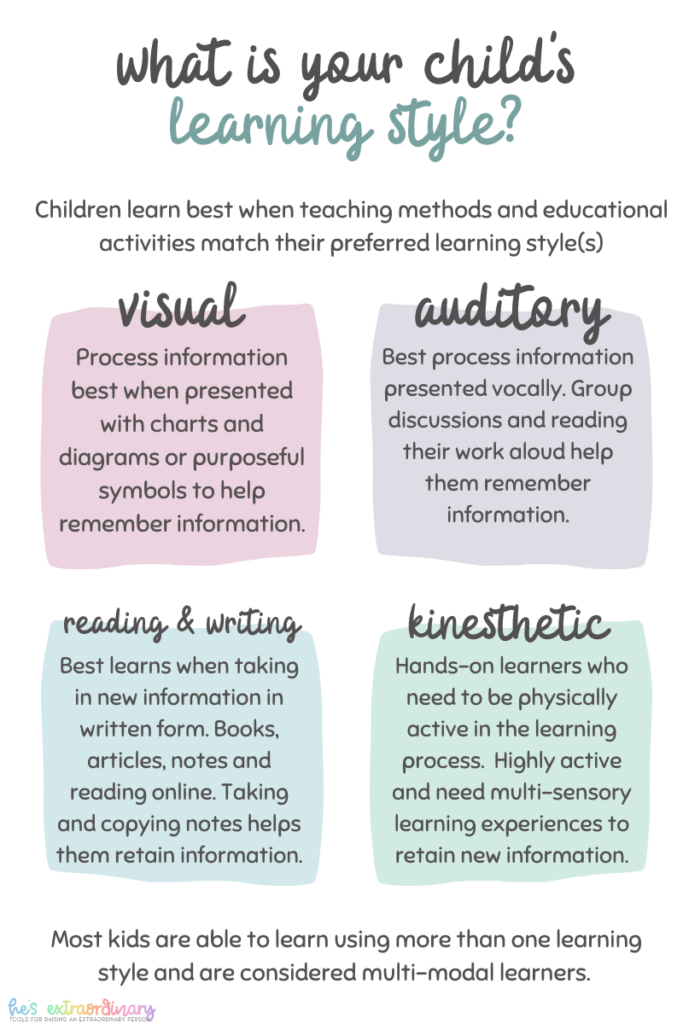How to Determine Your Child’s VARK Learning Style & Use it to Help Them Thrive
What’s inside this article: An overview of the VARK model, four learning styles, and how to determine your child’s learning style. Includes tips for using your child’s learning style to help them develop new skills.
As a parent – you are your child’s first teacher. It’s more challenging than many realize because all children are different and learn differently.
What’s easy to understand and learn for one child may be entirely inappropriate for another.
One way to help your child learn and thrive is to determine their learning style, so you can teach them how they learn best.
Experts have boiled things down to four defined learning styles, coined “The Vark Model.”
Read on to find out more about what it all means.
What is The Vark Model
The VARK model classifies individuals’ preferred learning styles. It came out of a study in the early 1990s by Neil D. Fleming and Coleen E. Mills.
It was the result of hundreds of hours of classroom observation until four distinct learning styles were defined. VARK is an acronym for these four learning styles:
- Visual
- Auditory
- Reading and writing
- Kinesthetic
Identifying learning styles is important because children learn best when teaching methods and educational activities match their learning styles, strengths, and preferences.

Visual Learners
Visual learners are children who process information when it’s given to them in a graphic depiction or purposeful symbols.
They tend to learn best when presented with charts and diagrams but not necessarily with videos or photos. They like to see the whole picture.
Auditory or Aural Learners
These children pick things up better when they hear information presented to them vocally.
Some may choose not to take notes because it disrupts their concentration. This does not necessarily mean they are less engaged.
Some children in this category benefit from group discussions about coursework or reading their own written work aloud.
Reading and Writing Learners
These children prefer learning from the written word in all its forms, including textbooks, articles, notes, and online research. They enjoy written assignments. Taking copious written notes can help them to process and retain information.
Kinesthetic Learners
Kinesthetic learners are hands-on and like to be physically active in the learning process.
People sometimes refer to them as “tactile learners.” However, they actually engage all their senses equally in the learning process. Multi-sensory educational activities are the best way to help them retain new information.
Kinesthetic learners are highly active. As a result, they may have the most difficulty in succeeding in conventional classroom settings.
Find more about the characteristics of kinesthetic learners, along with teaching strategies and educational activities, here.
The Importance of Understanding Your Child’s Learning Style
It would be very convenient if everyone learned the same way. The truth is that it’s not that simple.
Studies have shown that 50 to 70 percent of children are actually inclined toward more than one learning style. We call these children “multimodal learners.”
They often do well when we present them with information in several different forms that complement each other.
The main point is that we can improve how we teach our kids academics, life skills, and social-emotional learning once we understand how they learn.
Tips for Determining Your Child’s Learning Style
Determining your child’s learning style will help them develop new and lagging skills.
Here are some tips to help determine your child’s preferred learning style:
- Talk to your child and ask them for their thoughts about learning
- Observe how your child expresses themselves
- Look at what your child’s interests are
- Observe the ways your child solves problems
- Discuss their learning with their teachers
- Take a questionnaire that helps identify their learning style – see: The VARk Questionnaire
Understanding Your Child’s Learning Style
Once you’ve established how your child learns best, learn more about that learning style.
Find out which types of activities best help develop new skills and implement that information at home, such as cooking, cleaning, self-care, and skills like studying for tests and homework.
And also, use this information to help your child with social-emotional skills like self-regulation, sharing, manners, apologizing, personal space, etc.
There are several methods for teaching these skills, but choosing the ones that best benefit your child helps them thrive and meet their potential.
- Social narratives/stories
- Roleplay activities
- Modeling behavior
- Coaching and positive reinforcement
- Prompting
- Children’s books
- Visual supports
You can also share this information with your child’s teacher or even include specific types of learning activities in their 504 plan as well.

